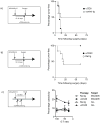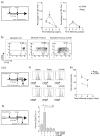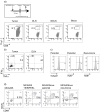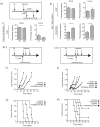Adjuvant therapy with agonistic antibodies to CD134 (OX40) increases local control after surgical or radiation therapy of cancer in mice
- PMID: 20842057
- PMCID: PMC3563298
- DOI: 10.1097/CJI.0b013e3181ee7095
Adjuvant therapy with agonistic antibodies to CD134 (OX40) increases local control after surgical or radiation therapy of cancer in mice
Abstract
The tumor recurrence from residual local or micrometastatic disease remains a problem in cancer therapy. In patients with soft tissue sarcoma and the patients with inoperable nonsmall cell lung cancer, local recurrence is common and significant mortality is caused by the subsequent emergence of metastatic disease. Thus, although the aim of the primary therapy is curative, the outcome may be improved by additional targeting of residual microscopic disease. We display in a murine model that surgical removal of a large primary sarcoma results in local recurrence in approximately 50% of animals. Depletion of CD8 T cells results in local recurrence in 100% of animals, indicating that these cells are involved in the control of residual disease. We further show that systemic adjuvant administration of αOX40 at surgery eliminates local recurrences. In this model, αOX40 acts to directly enhance tumor antigen-specific CD8 T-cell proliferation in the lymph node draining the surgical site, and results in increased tumor antigen-specific cytotoxicity in vivo. These results are also corroborated in a murine model of hypofractionated radiation therapy of lung cancer. Administration of αOX40 in combination with radiation significantly extended the survival compared with either agent alone, and resulted in a significant proportion of long-term tumor-free survivors. We conclude that αOX40 increases tumor antigen-specific CD8 T-cell cytotoxic activity resulting in improved endogenous immune control of residual microscopic disease, and we propose that adjuvant αOX40 administration may be a valuable addition to surgical and radiation therapy for cancer.
Figures





Similar articles
-
FcγRIIB engagement drives agonistic activity of Fc-engineered αOX40 antibody to stimulate human tumor-infiltrating T cells.J Immunother Cancer. 2020 Sep;8(2):e000816. doi: 10.1136/jitc-2020-000816. J Immunother Cancer. 2020. PMID: 32900860 Free PMC article.
-
Combined targeting of costimulatory (OX40) and coinhibitory (CTLA-4) pathways elicits potent effector T cells capable of driving robust antitumor immunity.Cancer Immunol Res. 2014 Feb;2(2):142-53. doi: 10.1158/2326-6066.CIR-13-0031-T. Epub 2013 Nov 11. Cancer Immunol Res. 2014. PMID: 24778278 Free PMC article.
-
PD-1 blockade and OX40 triggering synergistically protects against tumor growth in a murine model of ovarian cancer.PLoS One. 2014 Feb 27;9(2):e89350. doi: 10.1371/journal.pone.0089350. eCollection 2014. PLoS One. 2014. PMID: 24586709 Free PMC article.
-
CTLA-4 blockade increases antigen-specific CD8(+) T cells in prevaccinated patients with melanoma: three cases.Cancer Immunol Immunother. 2011 Aug;60(8):1137-46. doi: 10.1007/s00262-011-1011-9. Epub 2011 Apr 5. Cancer Immunol Immunother. 2011. PMID: 21465316 Free PMC article. Review.
-
Science gone translational: the OX40 agonist story.Immunol Rev. 2011 Nov;244(1):218-31. doi: 10.1111/j.1600-065X.2011.01069.x. Immunol Rev. 2011. PMID: 22017441 Free PMC article. Review.
Cited by
-
The confluence of radiotherapy and immunotherapy.Front Oncol. 2012 Oct 16;2:143. doi: 10.3389/fonc.2012.00143. eCollection 2012. Front Oncol. 2012. PMID: 23087904 Free PMC article.
-
The Common Costimulatory and Coinhibitory Signaling Molecules in Head and Neck Squamous Cell Carcinoma.Front Immunol. 2019 Oct 23;10:2457. doi: 10.3389/fimmu.2019.02457. eCollection 2019. Front Immunol. 2019. PMID: 31708918 Free PMC article. Review.
-
Preoperative stimulation of resolution and inflammation blockade eradicates micrometastases.J Clin Invest. 2019 Jun 17;129(7):2964-2979. doi: 10.1172/JCI127282. eCollection 2019 Jun 17. J Clin Invest. 2019. PMID: 31205032 Free PMC article.
-
Nano-Pulse Stimulation Treatment Inhibits Pan02 Murine Pancreatic Tumor Growth and Induces a Long-Term Adaptive Immune Response with Abscopal Effects When Combined with Immune-Enhancing Agents.Bioelectricity. 2024 Jun 12;6(2):108-117. doi: 10.1089/bioe.2024.0011. eCollection 2024 Jun. Bioelectricity. 2024. PMID: 39119566 Free PMC article.
-
Combination of OX40 Co-Stimulation, Radiotherapy, and PD-1 Inhibition in a Syngeneic Murine Triple-Negative Breast Cancer Model.Cancers (Basel). 2022 May 29;14(11):2692. doi: 10.3390/cancers14112692. Cancers (Basel). 2022. PMID: 35681672 Free PMC article.
References
-
- Shankaran V, et al. IFNgamma and lymphocytes prevent primary tumour development and shape tumour immunogenicity. Nature. 2001;410:1107–1111. - PubMed
-
- Morton DL. Changing concepts of cancer surgery: surgery as immunotherapy. Am J Surg. 1978;135:367–371. - PubMed
-
- Hsueh EC, et al. Does endogenous immune response determine the outcome of surgical therapy for metastatic melanoma? Annals of surgical oncology. 2000;7:232–238. - PubMed
Publication types
MeSH terms
Substances
Grants and funding
LinkOut - more resources
Full Text Sources
Other Literature Sources
Medical
Research Materials

